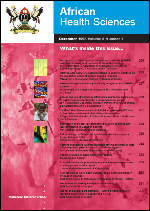
|
African Health Sciences
Makerere University Medical School
ISSN: 1680-6905
EISSN: 1680-6905
Vol. 13, No. 1, 2013, pp. 166-170
|
 Bioline Code: hs13026
Bioline Code: hs13026
Full paper language: English
Document type: Research Article
Document available free of charge
|
|
|
African Health Sciences, Vol. 13, No. 1, 2013, pp. 166-170
| en |
Bilateral giant inguinoscrotal Hernia: psychosocial issues and a new classification
Akpo, EE
Abstract
Background:Bilateral giant inguinoscrotal hernias pose challenging psychosocial problems to the patient. The engulfed
phallus and hernia size are socially embarrassing and may make penetration during coitus increasingly difficult and
uncomfortable. This paper presents a classification and the psychosocial aspects of bilateral giant inguinoscrotal hernias.
Methods:A prospective study of patients with bilateral giant inguinoscrotal hernia in which the phallus was completely
engulfed by the swelling, managed by this author between 2002 and 2011 in both urban and rural practice in Nigeria and
Sierra Leone was reviewed and analyzed using a simple frequency distribution.
Results:Eleven patients with bilateral giant inguinoscrotal hernias were reviewed. Age range 63-86 years. Mean age 73.73 ( ±
6.96SD) years. The reason for delayed presentation was financial constraint. Six patients (54.55%) presented due to continuous
refusal of coitus by their partners. Sexual satisfaction was poor in all the patients (100.00%). All the patients (100.00%) had
poor self-esteem and poor socialization habits as a result of continuous ridicule from peers and colleagues.
Conclusion:To improve quality of life of the elderly, there is the need for early awareness campaigns and provision of
improved access to free surgical health care services particularly in rural African communities.
Keywords
Bilateral giant inguinoscrotal hernia, classification, quality of life
|
| |
© Copyright 2012 - African Health Sciences
|
|
